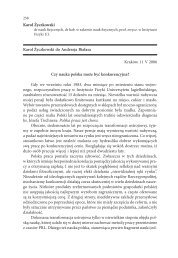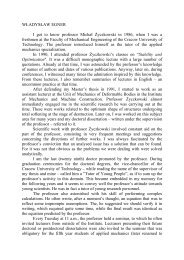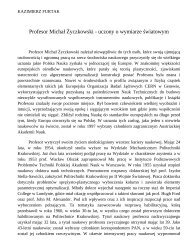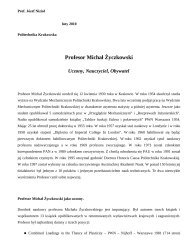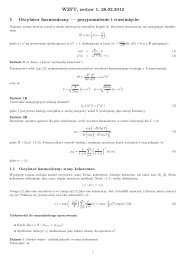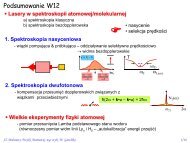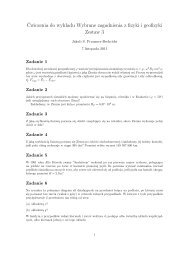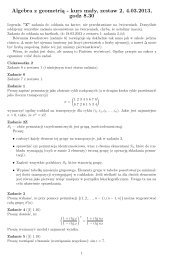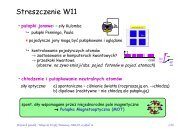Level Spacing Distribution Revisited - Theoretical Group Atomic ...
Level Spacing Distribution Revisited - Theoretical Group Atomic ...
Level Spacing Distribution Revisited - Theoretical Group Atomic ...
Create successful ePaper yourself
Turn your PDF publications into a flip-book with our unique Google optimized e-Paper software.
<strong>Level</strong> <strong>Spacing</strong> <strong>Distribution</strong> <strong>Revisited</strong><br />
Karol ˙Zyczkowski<br />
in collaboration with<br />
Tomasz Tkocz and Marek Ku´s (Warsaw)<br />
Institute of Physics, Jagiellonian University, Cracow, Poland<br />
and<br />
Center for <strong>Theoretical</strong> Physics, Polish Academy of Sciences<br />
IF UJ, Kraków, March 14, 2011<br />
K ˙Z (IF UJ/CFT PAN ) <strong>Level</strong> <strong>Spacing</strong> <strong>Distribution</strong> March 14, 2011 1 / 20
Quantum Chaos & Unitary Dynamics<br />
’Quantum chaology’: analogues of classically chaotic systems<br />
Quantum analogues of classically chaotic dynamical systems can be<br />
described by random matrices<br />
a) autonomous systems – Hamiltonians:<br />
Gaussian ensembles of random Hermitian matrices, (GOE, GUE, GSE)<br />
b) periodic systems – evolution operators:<br />
Dyson circular ensembles of random unitary matrices, (COE, CUE, CSE)<br />
K ˙Z (IF UJ/CFT PAN ) <strong>Level</strong> <strong>Spacing</strong> <strong>Distribution</strong> March 14, 2011 2 / 20
Random Matrices & Universality<br />
Universality classes<br />
Depending on the symmetry properties of the system one uses ensembles<br />
form<br />
orthogonal (β = 1);<br />
unitary (β = 2) and<br />
symplectic (β = 4) ensembles.<br />
The exponent β determines the level repulsion, P(s) ∼ s β for s → 0 where<br />
s stands for the (normalised) level spacing, si = φi+1 − φi.<br />
see e.g. F. Haake, Quantum Signatures of Chaos<br />
K ˙Z (IF UJ/CFT PAN ) <strong>Level</strong> <strong>Spacing</strong> <strong>Distribution</strong> March 14, 2011 3 / 20
Gaussian Ensembles of Hermitian matrices H<br />
Hermitian random matrix H = H †<br />
consists of independent Gaussian entries<br />
a) orthogonal ensemble, β = 1 - real random numbers,<br />
b) unitary ensemble, β = 2 - complex numbers (real at the diagonal!)<br />
c) symplectic ensemble, β = 4 - quaternions (2 × 2 matrices)<br />
leading to 2N × 2N matrix with each eigenvalue occurring twice.<br />
Different normalization conditions, we use the one implied by<br />
the normal distribution 〈Hij〉 = 0 and σ2 = 〈H2 ij 〉 = 1<br />
GUE ⇒ Unitary invariance, P(H) = P(UHU † )<br />
leads to joint probability distribution (jpd) of eigenvalues xi<br />
β P<br />
−<br />
Pβ(x1, . . .,xN) = CNe 2 j x2 j<br />
<br />
|xj − xk| β<br />
j
Wigner Semicircle Law<br />
Spectral density P(x)<br />
can be obtained by integrating out all eigenvalues but one from jpd.<br />
For all three Gaussian ensembles of Hermitian random matrices one<br />
obtains (asymptotically, for N → ∞) the Wigner Semicircle Law (1955)<br />
P(x) = 1 <br />
2 − x2 2π<br />
where x denotes a normalized eigenvalue, xi = λi/ √ N<br />
K ˙Z (IF UJ/CFT PAN ) <strong>Level</strong> <strong>Spacing</strong> <strong>Distribution</strong> March 14, 2011 5 / 20
K ˙Z (IF UJ/CFT PAN ) <strong>Level</strong> <strong>Spacing</strong> <strong>Distribution</strong> March 14, 2011 6 / 20
Extremal eigenvalues & Tracy–Widom Law<br />
Statistics of extremal cases - the largest eigenvalue xmax<br />
The normalized largest eigenvalue<br />
s := (xmax − 2 √ N)N −1/6<br />
of a GUE random matrix is (asymptotically) distributed according to the<br />
Tracy-Widom law (1994)<br />
F2(s) = det(1 − K) ,<br />
where K is the integral operator with the Airy kernel<br />
K(x, y) = Ai(x)Ai′ (y) − Ai ′ (x)Ai(y)<br />
.<br />
x − y<br />
The scaling behaviour of the finite size effect (as 1/N 1/6 )<br />
is due to Bowick & Brezin (1991) and Forrester (1991).<br />
K ˙Z (IF UJ/CFT PAN ) <strong>Level</strong> <strong>Spacing</strong> <strong>Distribution</strong> March 14, 2011 7 / 20
Tracy–Widom distributions<br />
Tracy–Widom distributions Fβ(s)<br />
<strong>Distribution</strong>s Fβ(s) and the largest eigenvalue<br />
of random GUE matrices<br />
(image by A. Edelman)<br />
K ˙Z (IF UJ/CFT PAN ) <strong>Level</strong> <strong>Spacing</strong> <strong>Distribution</strong> March 14, 2011 8 / 20
Some applications of Tracy–Widom Law<br />
Combinatorics: length of the longest increasing permutation<br />
Baik, Deift, Johansson (1999)<br />
Statistics: largest eigenvalues of correlation matrices C = XX T<br />
Johnstone (2001)<br />
Growth processes: fluctuations around the limiting shape<br />
Johansson (2000)<br />
Superconductors: fluctuations of excitation gap in a quantum dot<br />
Vavilov, Brouer, Ambegaokar, Benakker (2001)<br />
Random Tilings & Aztec Diamond: fluctuations around<br />
the Arctic Circle Johansson (2002)<br />
K ˙Z (IF UJ/CFT PAN ) <strong>Level</strong> <strong>Spacing</strong> <strong>Distribution</strong> March 14, 2011 9 / 20
Aztec Diamond & domino lattice<br />
Aztec diamond of order n – a region of 2n(n + 1) unit squares tiled with<br />
n(n + 1) dominos (i.e. union of two squares)<br />
The Aztec diamond<br />
of order n = 3<br />
K(3) = 2 6 = 64<br />
There exists exactly K = 2 n(n+1)/2 different domino tilings<br />
Elkies, Kuperberg, Larsen, Propp (1992)<br />
How a random Aztec Diamond looks like??<br />
K ˙Z (IF UJ/CFT PAN ) <strong>Level</strong> <strong>Spacing</strong> <strong>Distribution</strong> March 14, 2011 10 / 20
Random Domino & Arctic Circle Theorem<br />
Arctic Circle theorem - randomness inside the circle<br />
& ’Frozen Phase’ in four corners Jockush, Propp, Shor (1995)<br />
n = 50, K = 2 1275 ≈ 10 383<br />
Fluctuations around the Arctic Circle are described by<br />
the Tracy–Widom distribution F2 Johansson (2002)<br />
K ˙Z (IF UJ/CFT PAN ) <strong>Level</strong> <strong>Spacing</strong> <strong>Distribution</strong> March 14, 2011 11 / 20
Random matrices & Finite N Effects<br />
Analogy<br />
Infinite matrices ↔ semiclassical → 0 limit ↔ geometric optics<br />
diffraction and Airy discs<br />
Finite N Random Matrices ↔ Quantum Theory > 0 ↔ Wave<br />
Optics<br />
K ˙Z (IF UJ/CFT PAN ) <strong>Level</strong> <strong>Spacing</strong> <strong>Distribution</strong> March 14, 2011 12 / 20
<strong>Level</strong> spacing distribution P(s)<br />
Nearest neighbour spacing s<br />
si = xi+1−xi<br />
∆ where ∆ is the mean spacing<br />
a) Gaussian ensembles for N = 2 ⇒ Wigner surmise<br />
β = 1 GOE (orthogonal) P1(s) = π<br />
2s exp(−π 4s2 )<br />
β = 2 GUE (unitary) P2(s) = 32<br />
π 2s 2 exp(− 4<br />
π s2 )<br />
β = 4 GSE (symplectic) P4(s) = 218<br />
3 6 π 3s 4 exp(− 64<br />
9π s2 )<br />
These distributions derived for N = 2 work well also for Gaussian<br />
ensembles in the asymptotic case, N → ∞.<br />
Random unitary matrices & Circular ensembles of Dyson<br />
Uniform density of phases along the unit circle, P(φ) = 1/2π.<br />
Phase spacing, si = N<br />
2π [φi+1 − φi] since ∆ = 2π/N.<br />
For large matrices the level spacing distributions for Gaussian ensembles<br />
(Hermitian matrices) and circular ensembles (unitary matrices) coincide.<br />
K ˙Z (IF UJ/CFT PAN ) <strong>Level</strong> <strong>Spacing</strong> <strong>Distribution</strong> March 14, 2011 13 / 20
Composite systems & tensor products<br />
Consider tensor product of random matrices V = U1 ⊗ U2<br />
of size N, where Uj are random matrices according to the Haar measure<br />
(CUE). Eig(V) = {ψkm} = (αk + βm)|mod2π,<br />
where {αk} N k=1 and {βm} N m=1 denote spectra of U1 and U2.<br />
What is the (asymptotic) spacing distribution PCUE⊗CUE(s) ?<br />
Two qubits & random local gates<br />
Analytical results P2⊗2(s) for CUE(2) ⊗ CUE(2),<br />
(case by case analysis & direct integration)<br />
P2⊗2(s) = Θ(2 − s) 1<br />
<br />
2π (s − 2)sin2 ( πs<br />
4 ) π(s − 2) − 2 sin( πs<br />
2 )<br />
+ 1<br />
128π2 <br />
2(36 + π2 (s − 4) 2 ) + 128 cos( πs<br />
4 )<br />
+ (56 + π 2 (s − 4) 2 )cos( πs<br />
2 )<br />
K ˙Z (IF UJ/CFT PAN ) <strong>Level</strong> <strong>Spacing</strong> <strong>Distribution</strong> March 14, 2011 14 / 20
<strong>Level</strong> spacing for unitary matrices of order N = 4<br />
Comparison of spacing distribution P(s) for<br />
a) Poisson CPE(4), b) CUE(2) ⊗ CUE(2), c) CUE(4),<br />
Poisson ensemble, β = 0, CPE(4), P (4)<br />
0 (s) = (1 − s/4)3 ,<br />
Large matrices, N → ∞ asymptotics P (∞)<br />
0 (s) = e −s ,<br />
K ˙Z (IF UJ/CFT PAN ) <strong>Level</strong> <strong>Spacing</strong> <strong>Distribution</strong> March 14, 2011 15 / 20
Extremal spacings distributions<br />
for random unitary matrices<br />
consider a) Minimal spacing smin = minj{sj} N j=1<br />
and b) Maximal spacing smax = maxj{sj} N j=1<br />
Minimal spacing distribution for N = 4 random unitary matrices<br />
Two qubits & random local gates<br />
Analytical results P2⊗2(t) for CUE(2) ⊗ CUE(2) case, where t = smin<br />
P2⊗2(t) = 1<br />
<br />
2π(1−t)<br />
4π<br />
4−cos( πt<br />
2 )−3 sin( πt<br />
2<br />
)+8 sin(πt)−3 sin(3πt<br />
2 )<br />
<br />
CUE, β = 2, CUE(4), P (2)<br />
4 (t) = ... explicit result to long to reproduce it<br />
here...<br />
Poisson ensemble, β = 0, CPE(4), P (0)<br />
4 (t) = 3(1 − t)2 .<br />
K ˙Z (IF UJ/CFT PAN ) <strong>Level</strong> <strong>Spacing</strong> <strong>Distribution</strong> March 14, 2011 16 / 20
Minimal spacing P(smin) for N = 4 unitary matrices<br />
Comparison of spacing distribution P(smin) for<br />
a) Poisson CPE(4), b) CUE(2) ⊗ CUE(2), c) CUE(4).<br />
mean values: 〈smin〉CPE4 = 1/4, 〈smin〉CUE2⊗CUE2 ≈ 0.4,<br />
〈smin〉CUE4 ≈ 0.54<br />
K ˙Z (IF UJ/CFT PAN ) <strong>Level</strong> <strong>Spacing</strong> <strong>Distribution</strong> March 14, 2011 17 / 20
Average minimal spacing 〈smin〉 for large unitary<br />
matrices<br />
Approximation of independent spacings<br />
Assume spacings sj described by the distribution Pβ(s) are independent.<br />
Minimal spacing<br />
Since for small spacings Pβ(s) ∼ s β so the integrated distribution<br />
I(s) = s<br />
0 P(s′ )ds ′ behaves as Iβ(s) ∼ s 1+β<br />
Matrix of order N yields N spacings sj. The minimal spacing smin occurs<br />
for such an argument that Iβ(smin) ≈ 1/N.<br />
Thus (smin) 1+β ≈ 1/N =⇒ smin ≈ N −β−1<br />
K ˙Z (IF UJ/CFT PAN ) <strong>Level</strong> <strong>Spacing</strong> <strong>Distribution</strong> March 14, 2011 18 / 20
Average maximal spacing 〈smax〉<br />
Approximation of independent spacings<br />
Assume spacings sj described by the distribution Pβ(s) are independent.<br />
Mean maximal spacing for COE<br />
Since for large spacings Pβ(s) ∼ s 1 exp(−s 2 ) so the integrated<br />
distribution<br />
I1(s) = s<br />
0 P(s′ )ds ′ behaves as I1(s) ∼ −exp(−s 2 )<br />
Matrix of order N yields N spacings sj. The maximal spacing smax occurs<br />
for such an argument that 1 − I1(smax) ≈ 1/N.<br />
Thus exp[−(smax) 2 ] ≈ 1/N =⇒ smax ≈ √ lnN<br />
However,<br />
K ˙Z (IF UJ/CFT PAN ) <strong>Level</strong> <strong>Spacing</strong> <strong>Distribution</strong> March 14, 2011 19 / 20
Average maximal spacing 〈smax〉<br />
Approximation of independent spacings<br />
Assume spacings sj described by the distribution Pβ(s) are independent.<br />
Mean maximal spacing for COE<br />
Since for large spacings Pβ(s) ∼ s 1 exp(−s 2 ) so the integrated<br />
distribution<br />
I1(s) = s<br />
0 P(s′ )ds ′ behaves as I1(s) ∼ −exp(−s 2 )<br />
Matrix of order N yields N spacings sj. The maximal spacing smax occurs<br />
for such an argument that 1 − I1(smax) ≈ 1/N.<br />
Thus exp[−(smax) 2 ] ≈ 1/N =⇒ smax ≈ √ lnN<br />
However, these results (and many more) appeared recently (October 2010)<br />
in a preprint arXiv:1010.1294 ”Extreme gaps between eigenvalues of<br />
random matrices” by Ben Arous and Bourgade.<br />
K ˙Z (IF UJ/CFT PAN ) <strong>Level</strong> <strong>Spacing</strong> <strong>Distribution</strong> March 14, 2011 19 / 20
Concluding Remarks<br />
Random Matrices:<br />
a) offer a useful tool applicable in several branches of science<br />
including physics !<br />
b) display (asymptotically) universal properties, which depend on<br />
the symmetry with respect to orthogonal / unitary / symplectic<br />
transformations<br />
Limit N → ∞ corresponds to the semiclassical limit of quantum<br />
theory or geometric optics as a limiting case of wave optics!<br />
Problem of extremal eigenvalues is described by Tracy–Widom<br />
distributions.<br />
The analogous problem of extremal spacings is studied only recently<br />
Preliminary results on spectral statistics of local unitary evolution<br />
operators (with tensor product structure).<br />
K ˙Z (IF UJ/CFT PAN ) <strong>Level</strong> <strong>Spacing</strong> <strong>Distribution</strong> March 14, 2011 20 / 20






